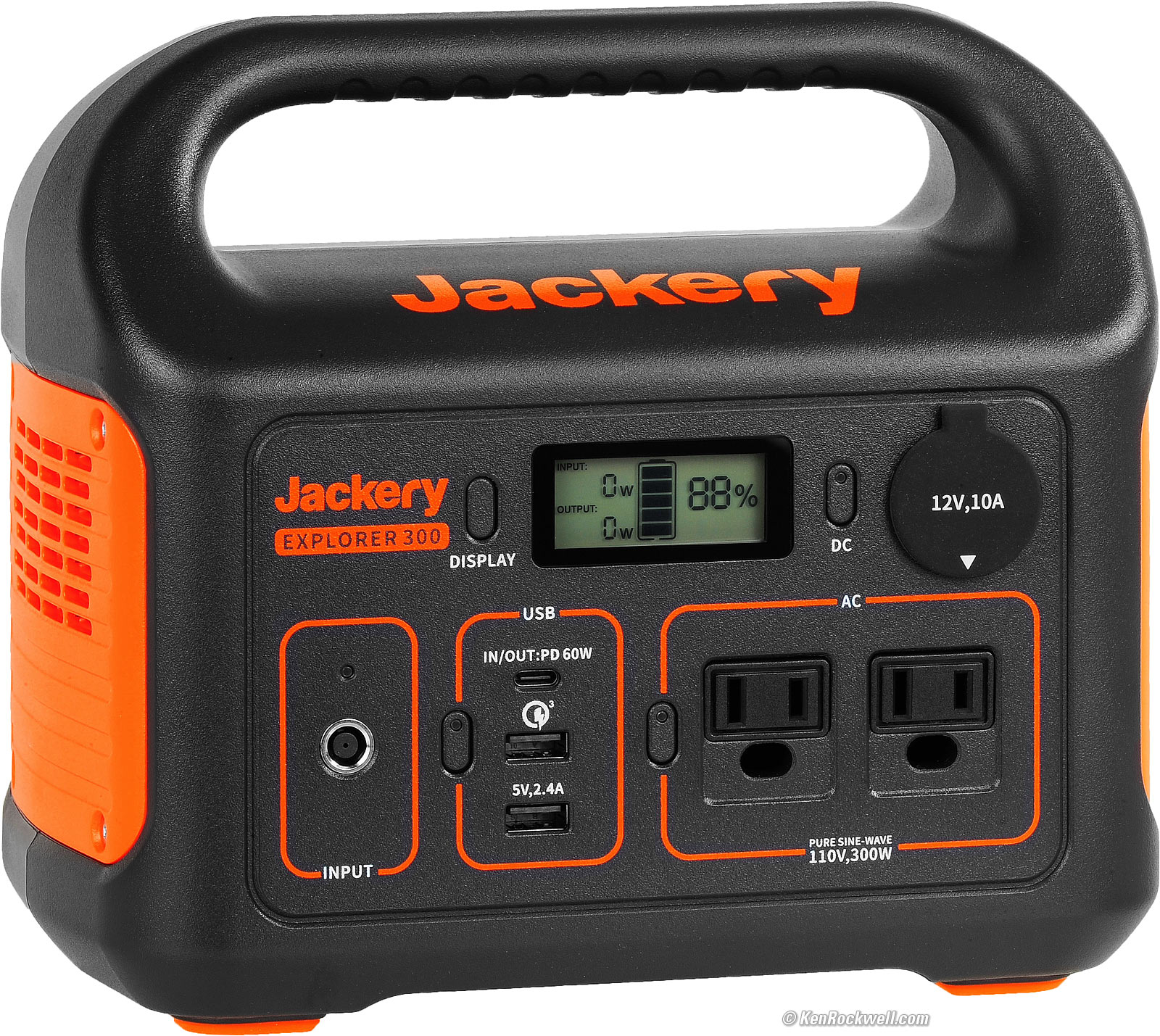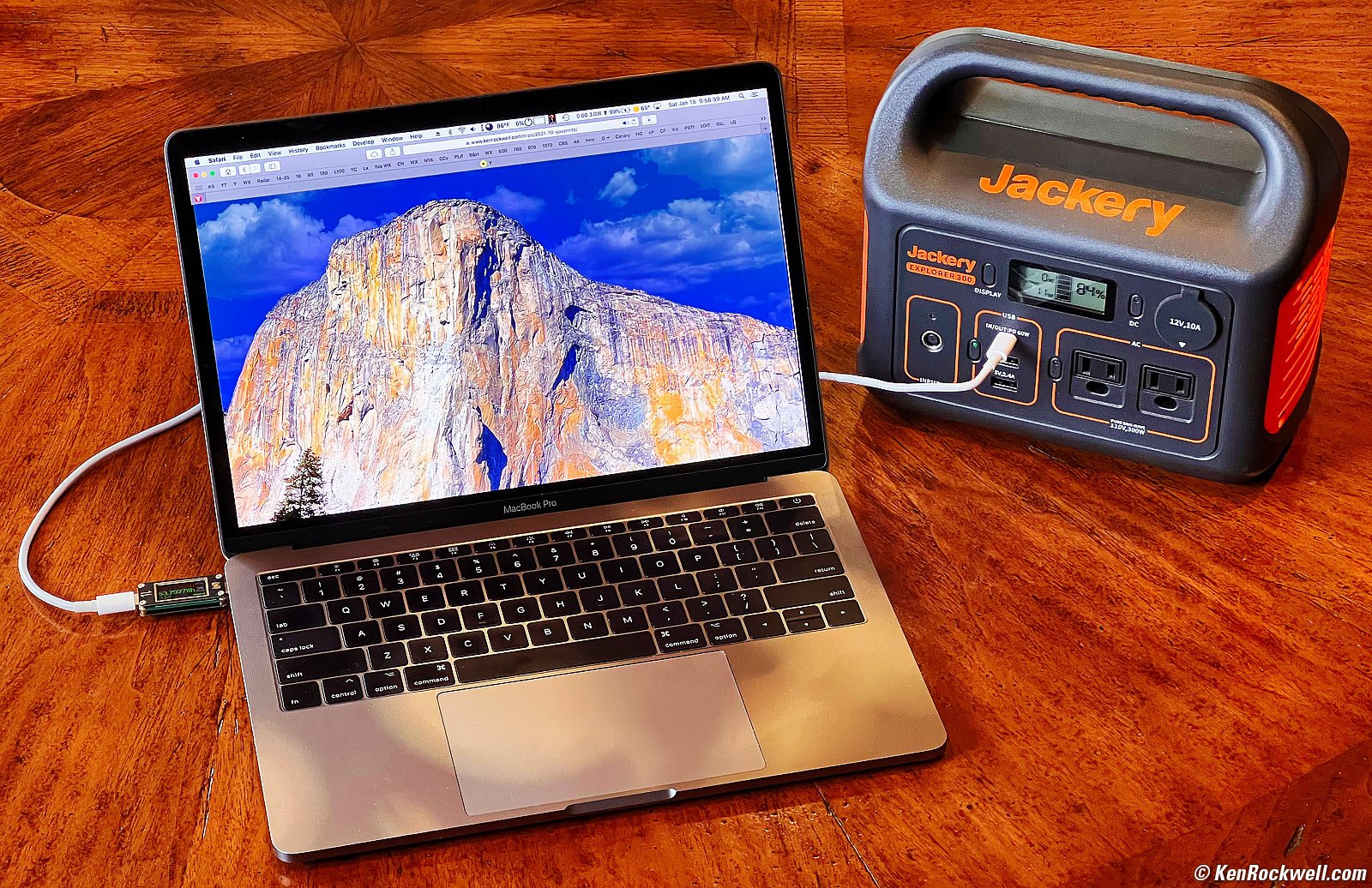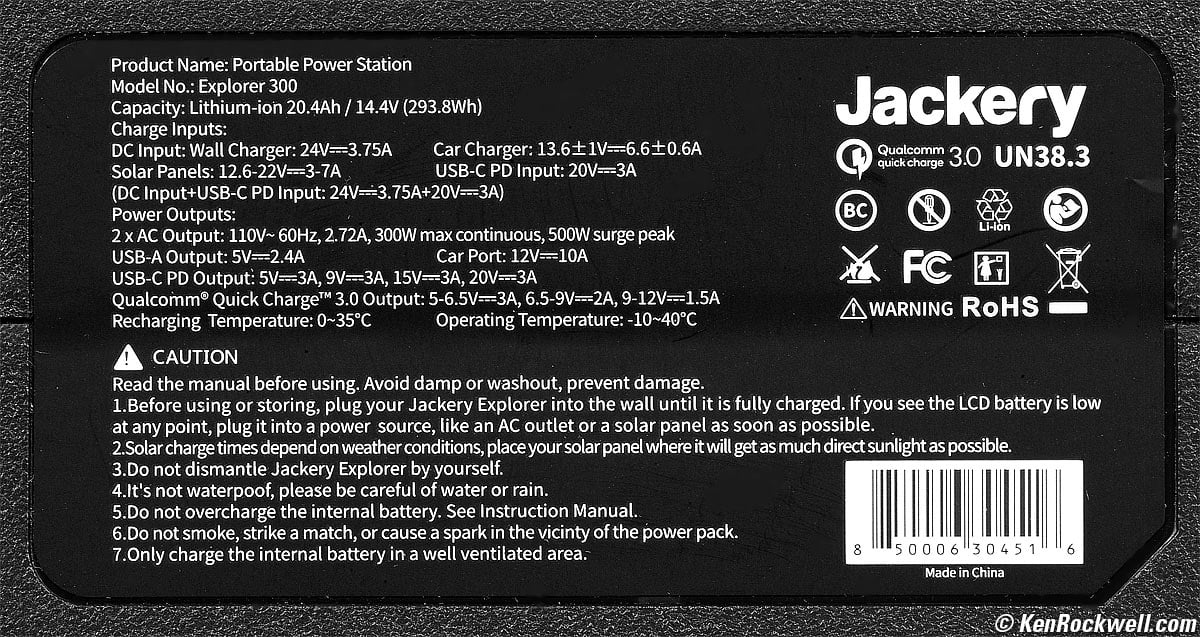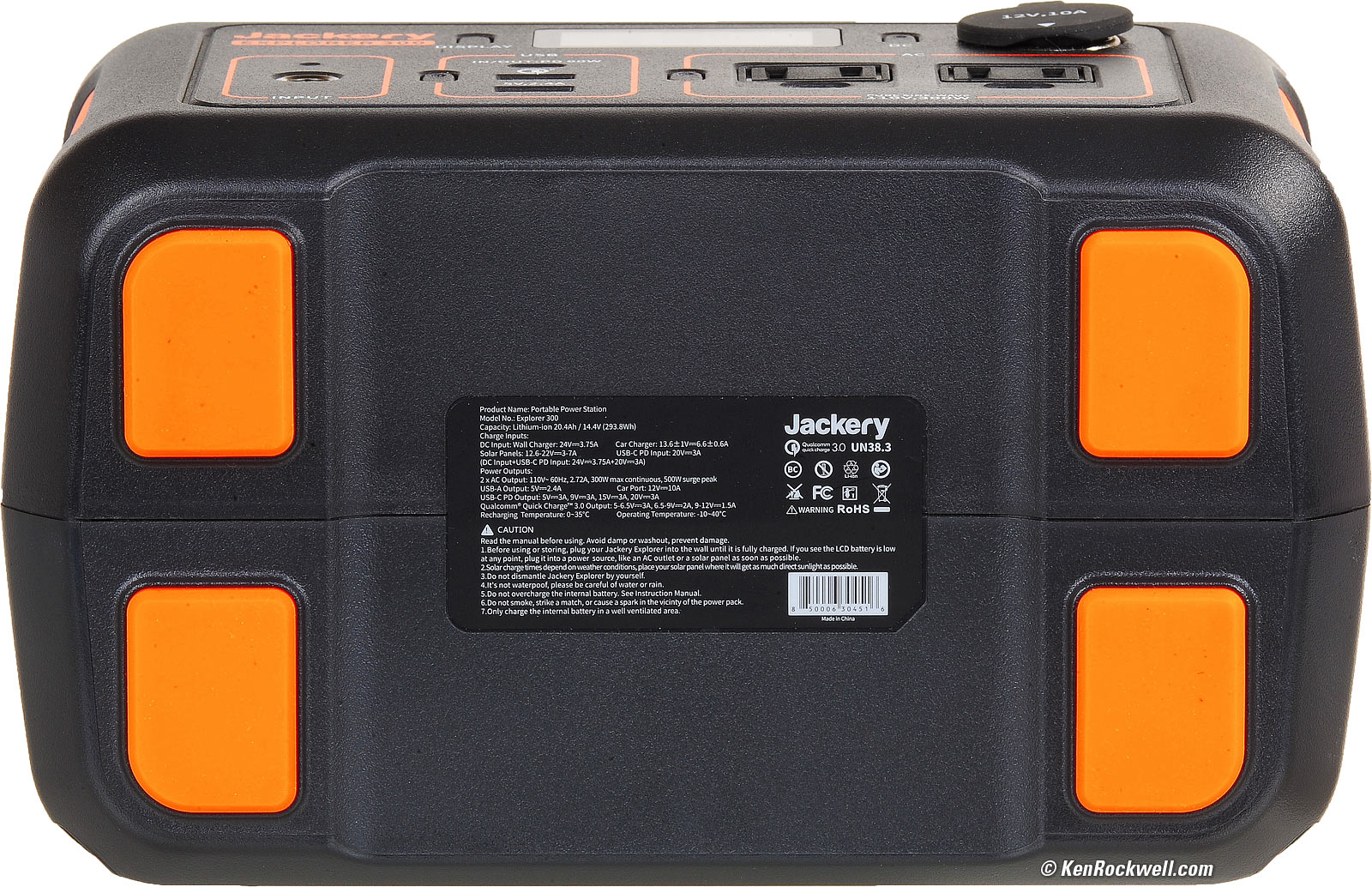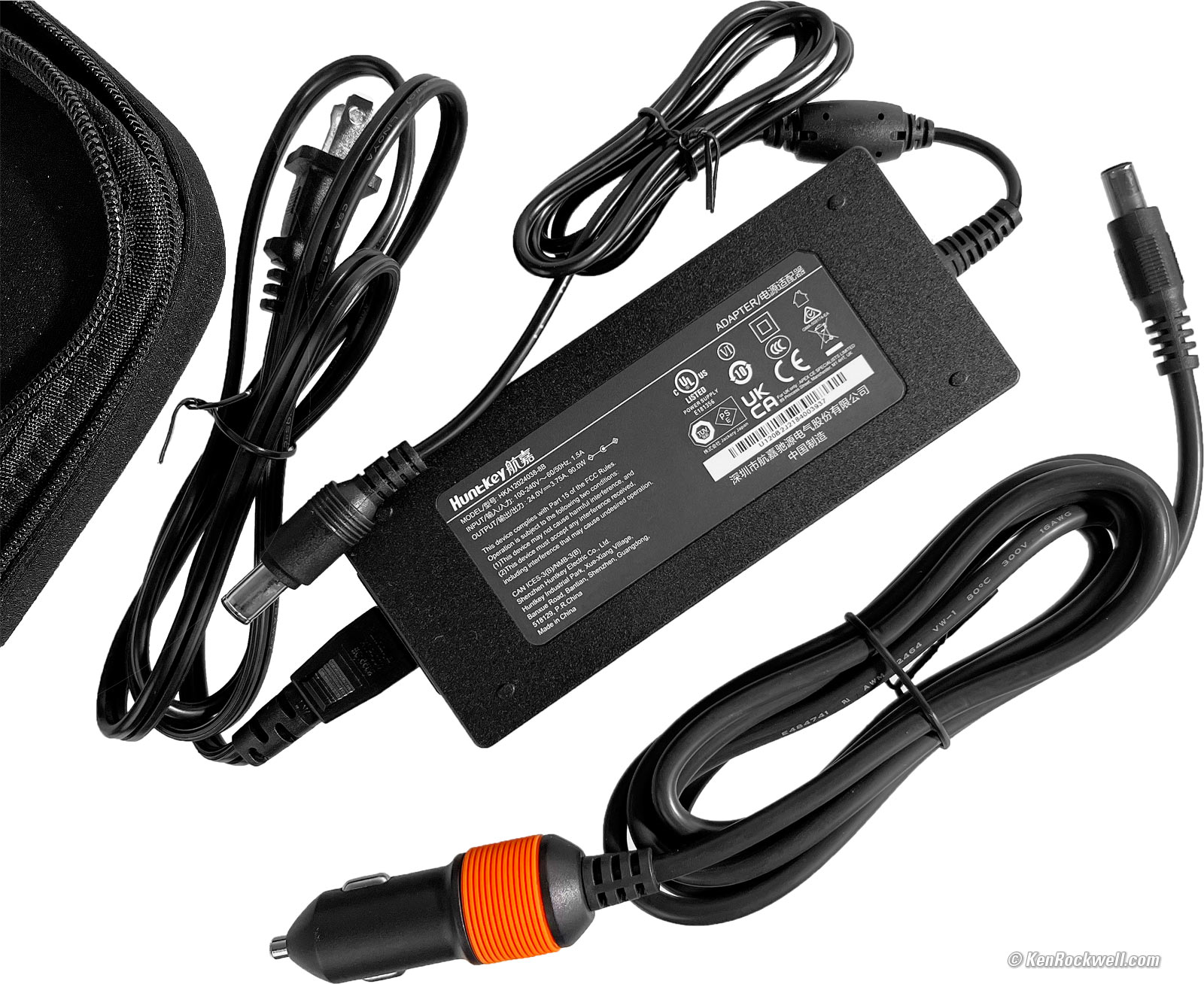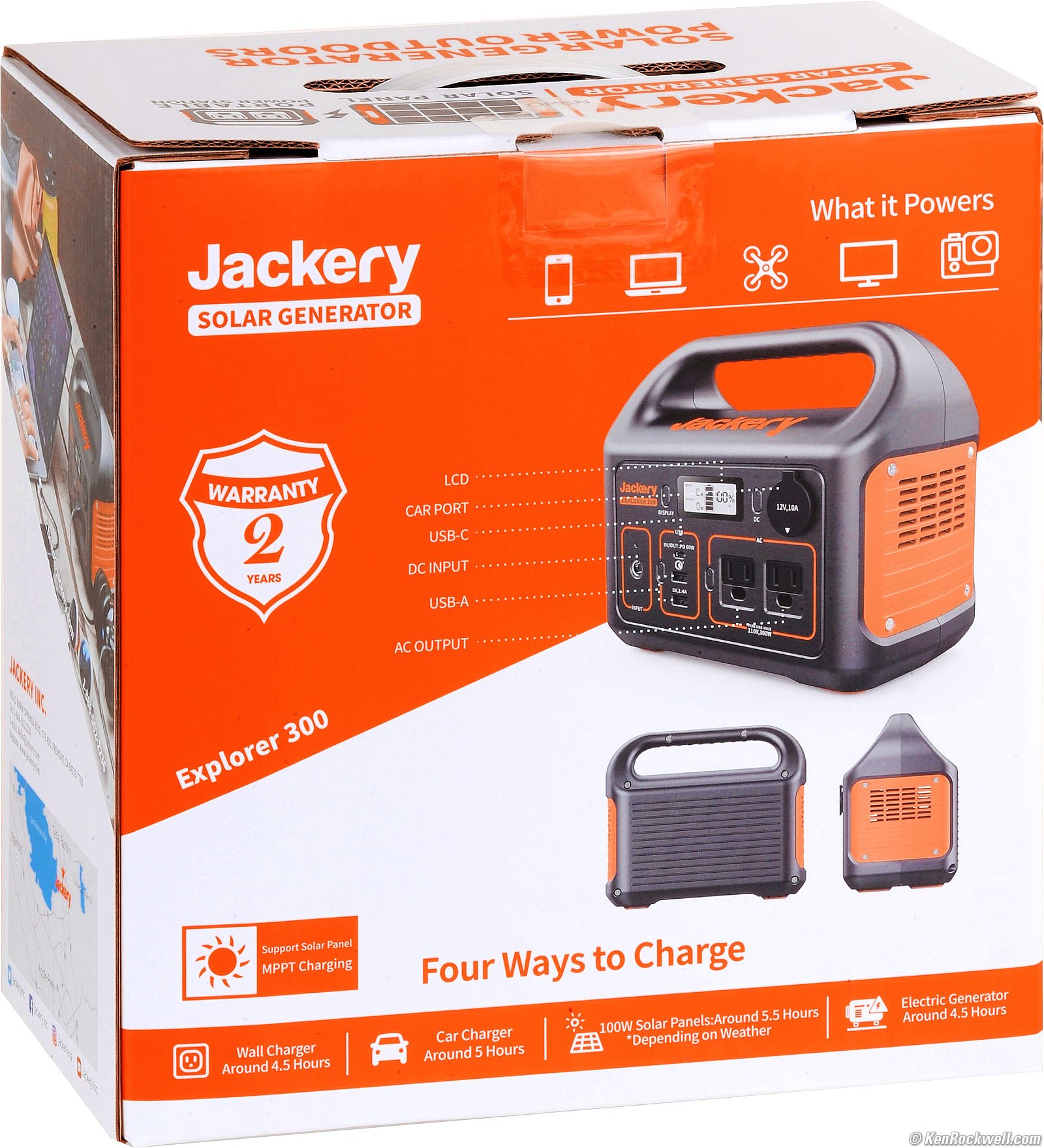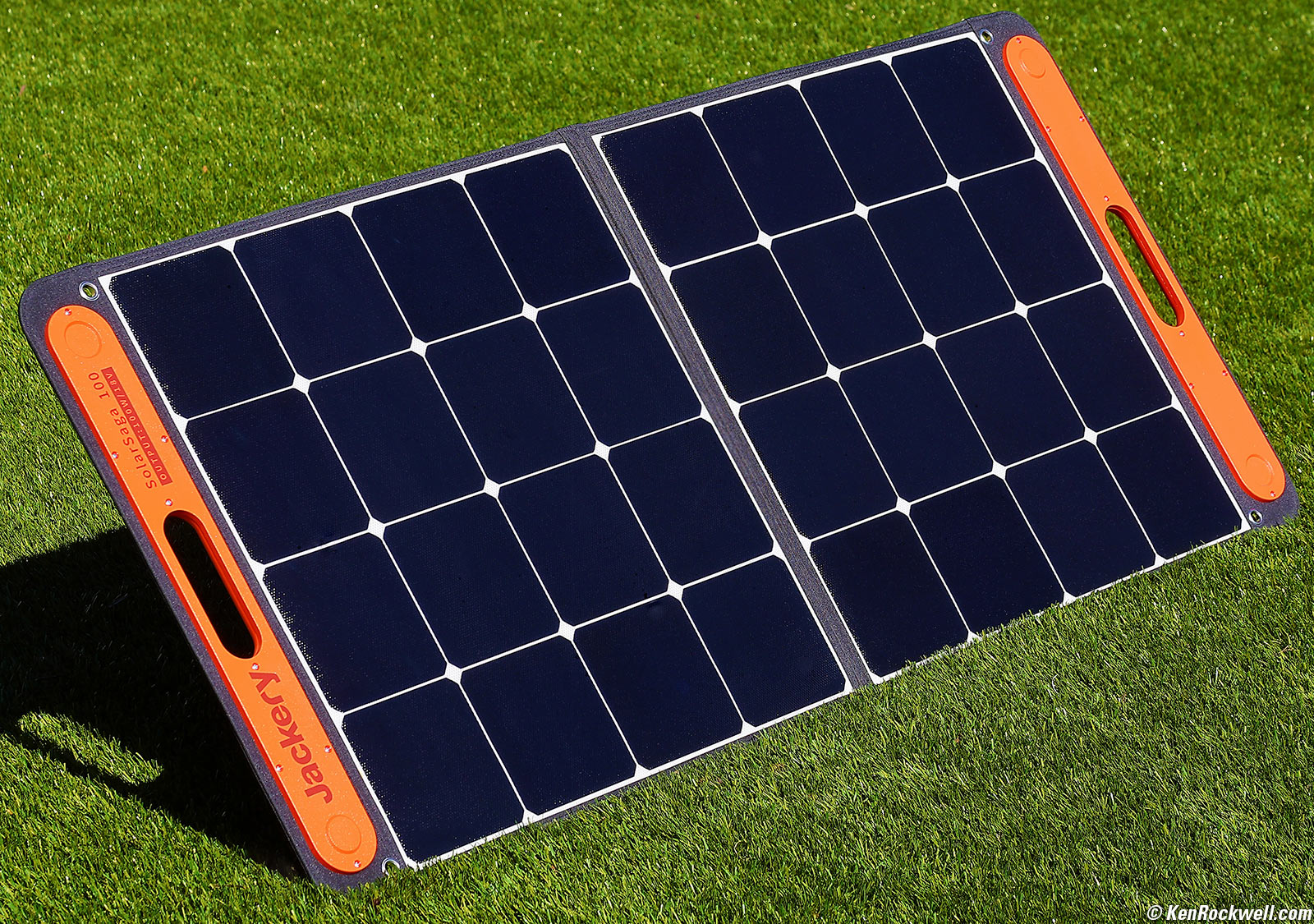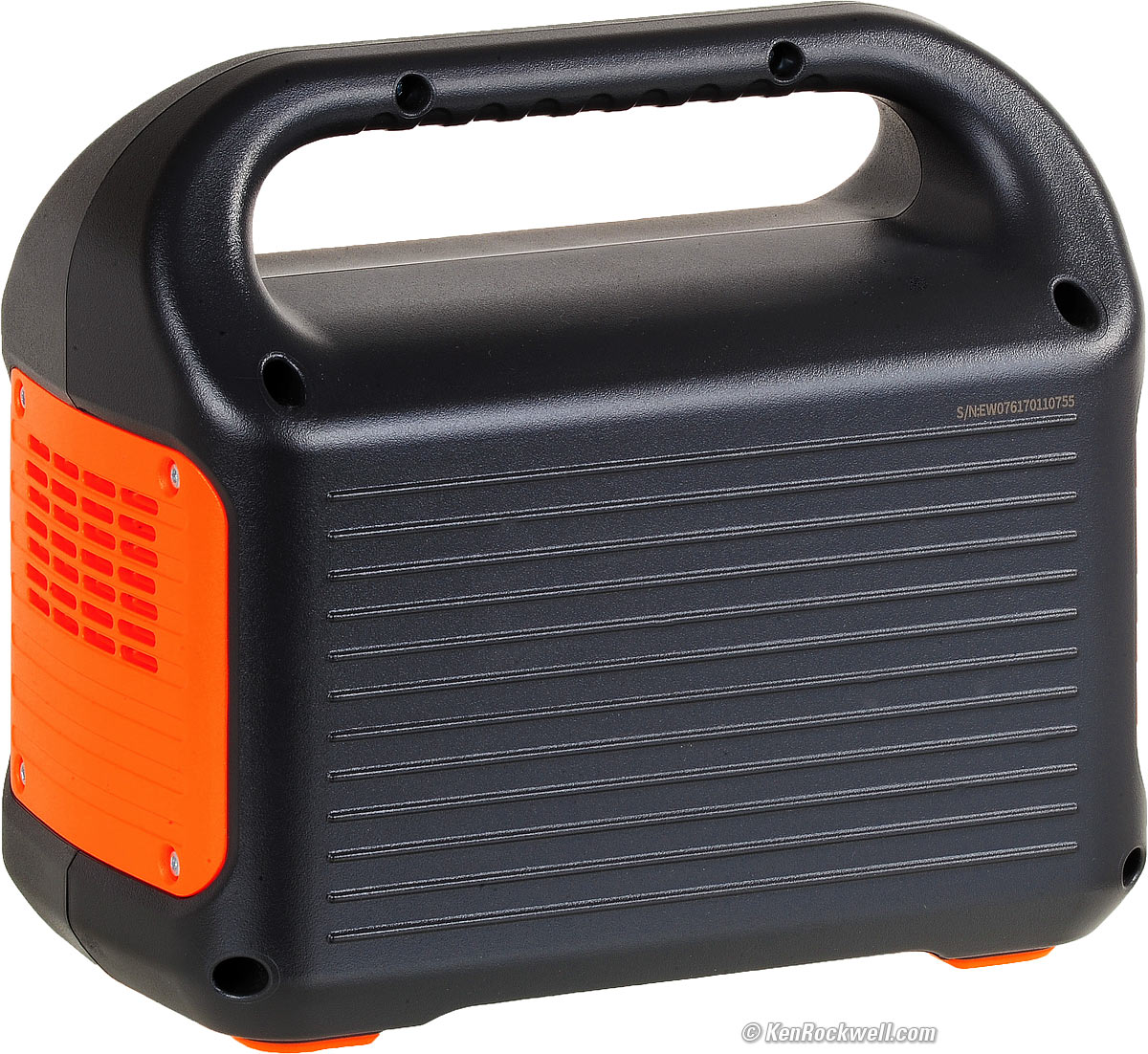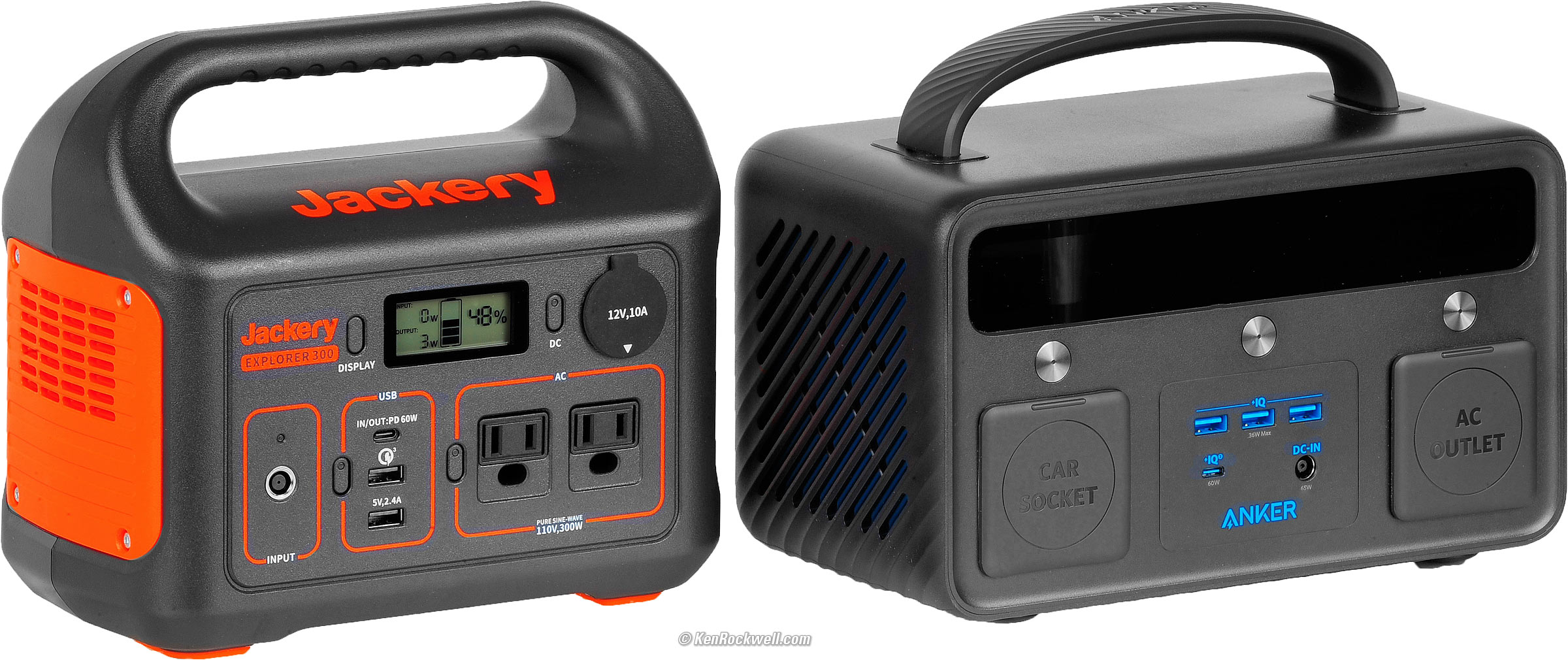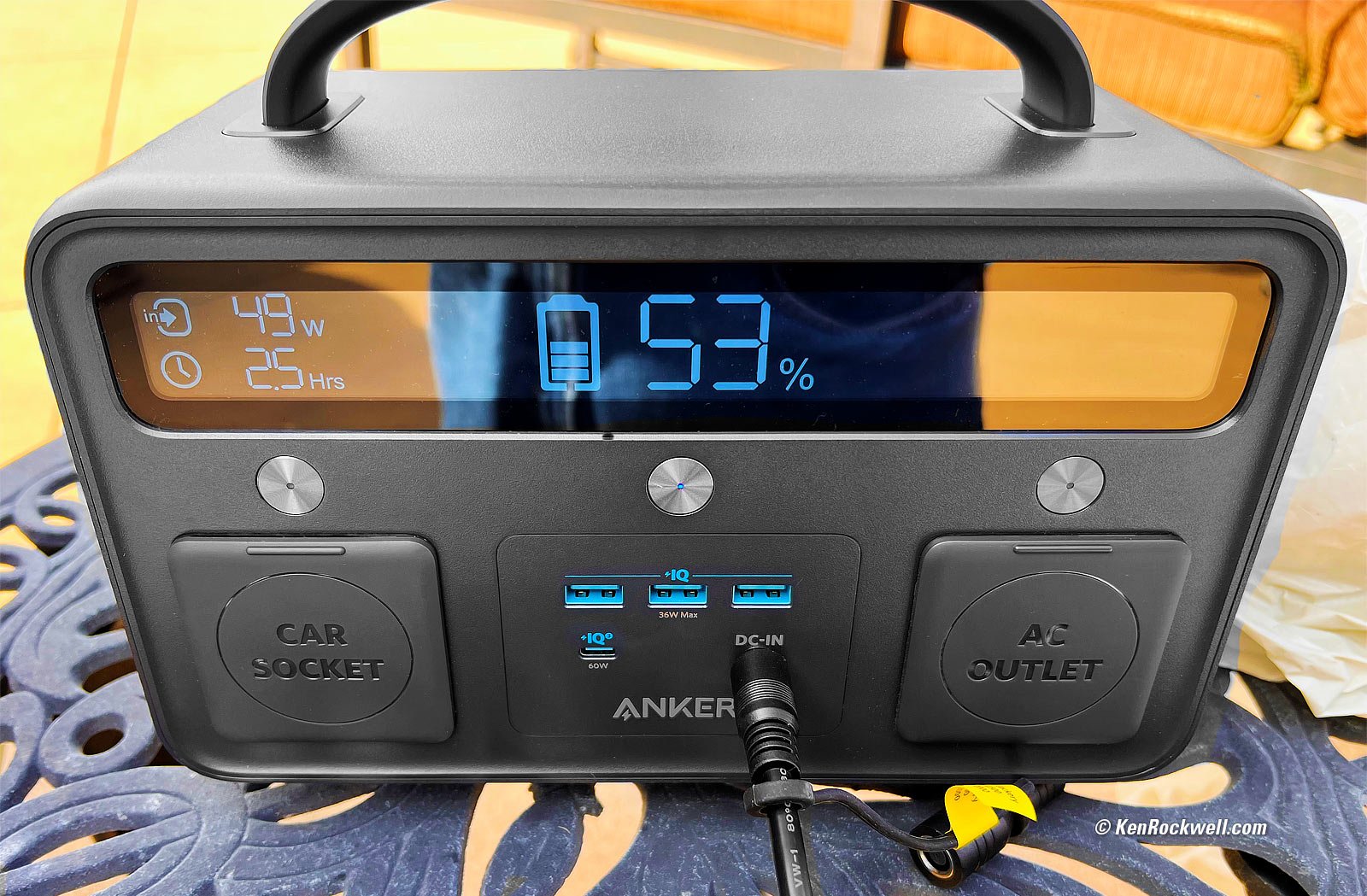Jackery Explorer 300 Power Station
294 Wh battery w/300 W AC, 120W 12VDC, 60W USB-C PD & 18W USB-A outputs
Specifications Optional Accessories
Jackery Explorer 300 (118.2 oz./3,350g/7.4 lbs., $299.99). bigger. I got mine from Amazon. I'd also get it at eBay if you know How to Win at eBay.
The Solar Generator set includes the SolarSaga 100W solar panel along with this Explorer 300 Power Station.
This all-content, junk-free website's biggest source of support is when you use those or any of these links to approved sources when you get anything, regardless of the country in which you live. Thanks for helping me help you! Ken.
February 2022 Better Pictures Jackery Canon Nikon Sony Fuji All Reviews
Introduction top
Specifications Optional Accessories
|
|
A power station is a big power bank. It's a big battery with inverters to provide whatever sort of power you'd like. You can use whichever outputs you like at the same time; each section has its own switch.
You charge this through the DC INPUT on the left with the included AC-to-DC adapter, the included 12V DC car charging cord or an optional solar panel, and/or you can charge it through its USB-C PD input. For faster charging you can charge through both the DC INPUT and the USB-C PD inputs at the same time.
Charge this power station with a solar panel and the combination is called a solar generator. It's much bigger than a power bank, and it's still much more portable than any gasoline generator.
The solar panel charges it in just a couple of hours, and it's just as fast as plugging it in the wall — and solar power is free.
You don't want to leave your valuables sitting outside to charge directly from the solar panel, so charge this by day and then charge and run everything later from the power station.
You can use this while it's charging. You might want extension cord(s) if you want to work away from the solar panel, or get more than one power station and run from one while the other is charging.
You can charge at school, in your car or office during the day and then use the power at home at night.
Charge in the hotel or your RV each night and run everything from it on location all day, or just keep it charged at home for emergency power. Charge from solar or OPP (other people's power) and your power is free!
For my light-duty uses, running my MacBook Pro and charging my cameras, iPhones and iPads, a couple of hours of charge provides for days of heavy use, so I can charge whenever I like and run from the power station most of the time.
Its battery is big enough (294 Wh or "80,000 mAh" in power bank terms) that I have clocked that it can charge and run my MacBook Pro for about 20 hours of hard all-day Photoshop and web development use with numerous card readers and peripheral drives! That's a few days of full-time heavy professional use or a week of more of rational use like just web browsing, sucking only about 4% of the battery charge per hour. With casual use of just my MacBook Pro as shown here it ought to run about 30 hours just from the Explorer 300:
Jackery Explorer 300 running my MacBook Pro. bigger.
Unlike a gasoline generator, it's completely silent and safe to use indoors. It's just a battery:
Jackery Explorer 300 running my MacBook Pro. The device on my cable at my MacBook Pro is an accumulating wattmeter I use for battery capacity measurements. bigger.
MacBook Pros usually have plenty of juice to run all day, however an advantage to this power station is I can run fast and hard without worrying about screen brightness, processor loads or even bothering to check any battery gauges.
While I'd suggest the Explorer 1000 for running a full desktop system, big monitors and pro audio system, even this Explorer 300 easily drives my complete desktop system with a 55" 4K monitor and a full complement of class A and class AB audio monitors and biamplified powered subwoofers, DACs and crossovers. It won't run it more than an hour or so (that system draws 150W or more), which is why the Explorer 1000 is a smarter idea for running a high-power desktop system for many hours, but this compact power station does indeed run it all. The Explorer 1000 charges from the same sources.
This Explorer 300 is not happy driving my 500 watt-second Novatron studio strobe power pack; it draws too much surge power. It works, but moans and groans and turns its internal fan on and off. The Explorer 1000 should do this easily, but I haven't tried yet. The Explorer 1000 should let me bring my big, fat American-made studio strobes out anywhere to shoot.
My Explorer 300 easily runs all the Luxli LED lights in my video studio (two Timpani and one Cello), as well as my TASCAM DR100 Mk II audio recorder and phantom-powered microphones. With the Timpani at 67% and the Cello at 35%, everything draws only 125W total. Be careful; the Explorer 300's internal fan turns on at about this power if you don't want that interfering with your audio. No big deal; LED lights draw much less power in practice than they're rated
The Explorer 300 is light enough to grab-and-go wherever I want to run or charge. It's always easier to grab it when I need to charge anything rather than looking for a wall socket or extension cord.
It's much easier to grab this to provide AC, DC, USB and/or PD power rather than mess with extension cords when I'm crawling around troubleshooting. It's also easier to grab this instead of a long extension cord to power a work light. I've already used this to troubleshoot my hot water heater's recirculation pump: it was easier to grab this than to find my multimeter and extension cords.
Ditto for running my classic Made-in-U. S. A. orange Celestron 8 astronomical telescope's AC-powered clock drive. It's much easier to take this to my backyard rather than run an extension cord — and it's perfect for use nowhere near AC power with its frequency-accurate "pure sine wave" output.
The power station lets me be cordless, whether for my telescope at night, running my laptop on a kitchen or outdoor patio table or at an on-set workstation. The power station eliminates power cords running across the ground, preventing people from tripping and damaging expensive equipment.
Would you rather have to go find a land-line telephone mounted to the wall, or just grab your cell? With this power station you no longer have to go find a wall outlet or use a long cord every time you charge.
I love using this because it has every kind of power I need. I just grab-and-go to power or charge anything without having to find the right charger and then finding a wall outlet and/or extension cord.
It has a huge battery. It can run all week charging most things so I only have to charge the Explorer 300 once a week or less, or whenever it's convenient.
I got my Explorer 300 from Amazon. I'd also get it at eBay if you know How to Win at eBay.
Good intro top
 Solid, reliable and well-regulated power at all loads in a compact package.
Solid, reliable and well-regulated power at all loads in a compact package.
 Charges fast from the SolarSaga 100W solar panel or other sources.
Charges fast from the SolarSaga 100W solar panel or other sources.
 Charges from just about anything from 12 to 24 V DC: a solar panel, the included AC-to-DC adapter, the included 12V DC car cord, or any other DC source like my 12V DC hard drive power supply, so long as you have a 7.9 × 0.9mm plug on the end. More at Charging.
Charges from just about anything from 12 to 24 V DC: a solar panel, the included AC-to-DC adapter, the included 12V DC car cord, or any other DC source like my 12V DC hard drive power supply, so long as you have a 7.9 × 0.9mm plug on the end. More at Charging.
 Also charges from just about anything USB: regular USB-C, USB PD or even from a USB-A with the right cord. More at Charging.
Also charges from just about anything USB: regular USB-C, USB PD or even from a USB-A with the right cord. More at Charging.
 You can use charge from two sources at once for faster charging. More at Charging.
You can use charge from two sources at once for faster charging. More at Charging.
 Display LCD always active while charging or operating, but the backlight always times-out after 15 seconds.
Display LCD always active while charging or operating, but the backlight always times-out after 15 seconds.
 Very efficient converters and inverters; the AC inverter only seems to draw a few watts at idle and the 12VDC and USB outputs draw less than a watt at idle, so it's no big deal to leave any of these on for extended periods and not have to worry about wasting power if an output is unused.
Very efficient converters and inverters; the AC inverter only seems to draw a few watts at idle and the 12VDC and USB outputs draw less than a watt at idle, so it's no big deal to leave any of these on for extended periods and not have to worry about wasting power if an output is unused.
 Display backlight blinks ten times when you hit 20% on discharge to warn you. Also is supposed to do the same at 10%, but my sample dies at 12%.
Display backlight blinks ten times when you hit 20% on discharge to warn you. Also is supposed to do the same at 10%, but my sample dies at 12%.
Bad intro top
 I measured the battery capacity and it is as advertised, but the power station's output dies when the battery gauge reads 12%. It's like having a car that dies when the gas gauge reads 1/8, even though it has the correct tank size and range.
I measured the battery capacity and it is as advertised, but the power station's output dies when the battery gauge reads 12%. It's like having a car that dies when the gas gauge reads 1/8, even though it has the correct tank size and range.
 Like many PD dual inputs and outputs, if you forget to turn on the USB section for it to be a power source, the Explorer 300 will think that you are wanting to charge it from the PD source connected to it, so it will suck power from your USB-C PD power bank, iPads or MacBook Pro to charge itself. Yes, you can charge the Explorer 300 from these devices, but you probably don't want to. Since the Explorer 300 has a battery about six or more times the size of an iPad or MacBook Pro, if you just plug one in without first pressing the button on the Explorer 300 to get the green LED, you'll probably suck your device dry trying to charge the power station. Be careful and look at the watt meters.
Like many PD dual inputs and outputs, if you forget to turn on the USB section for it to be a power source, the Explorer 300 will think that you are wanting to charge it from the PD source connected to it, so it will suck power from your USB-C PD power bank, iPads or MacBook Pro to charge itself. Yes, you can charge the Explorer 300 from these devices, but you probably don't want to. Since the Explorer 300 has a battery about six or more times the size of an iPad or MacBook Pro, if you just plug one in without first pressing the button on the Explorer 300 to get the green LED, you'll probably suck your device dry trying to charge the power station. Be careful and look at the watt meters.
Missing intro top
 No flashlight, work light or ambient light. (so plug one into one of its many outputs.)
No flashlight, work light or ambient light. (so plug one into one of its many outputs.)
 No time-till-empty or time-till-charged indicators.
No time-till-empty or time-till-charged indicators.
 The display LCD is always active while charging or operating, but the backlight times-out 15 seconds after each button-push. There is no way to keep the backlight on continuously.
The display LCD is always active while charging or operating, but the backlight times-out 15 seconds after each button-push. There is no way to keep the backlight on continuously.
 It reads power-in and power-out separately, so if you're using and charging at the same time it doesn't show net battery charge or drain; you'd have to do the math yourself.
It reads power-in and power-out separately, so if you're using and charging at the same time it doesn't show net battery charge or drain; you'd have to do the math yourself.
 Not waterproof.
Not waterproof.
 No storage compartment for small accessories or plug adapters.
No storage compartment for small accessories or plug adapters.
Specifications top
Specifications Optional Accessories
I got my Explorer 300 from Amazon. I'd also get it at eBay if you know How to Win at eBay.
Capacity specifications top
294 watt hours.
20.4Ah, 14.4V
Power Outputs specifications top
110 VAC
300 watts continuous.
500 watts surge.
12 V DC
10 A.
120 watts.
USB-C PD
60 watts (20V 3A).
USB-A QC 3.0
18 watts (12V 1.5A).
USB-A
12 watts (5V 2.4A).
Charging Inputs specifications top
You may charge with both of these at the same time for faster charging, up to 150 watts total:
USB-C PD Input
60W
and/or
DC Input
7.9 x 0.9mm (DC7909) input jack.
12.6 ~ 24 V DC.
90 watts maximum from solar panel, car cord or AC -to-DC wall adapter.
Jackery Explorer 300. bigger.
Jackery Explorer 300. bigger.
Nice, big rubbery feet.
Auto Shutoff specifications top
No automatic shutoff on DC outputs: the USB or 12V outputs stay on until you turn them off.
Shuts off after 12 hours with less than 10W drawn from the AC outputs.
Size specifications top
7.8 × 9.1 × 5.2 inches HWD.
198 × 231 × 132 millimeters HWD.
Weight specifications top
7.4 pounds (118.2 oz. or 3,350 g) actual measured weight.
Rated 7.1 pounds (3,200 g).
Quality specifications top
Made in China.
Environment specifications top
Charging
0 ~ +35º C (32 ~ 95º F).
Discharging
-10 ~ +40º C (14 ~ 104º F).
Included specifications top
Included AC power adapter, DC cord to charge from your car's power sockets and their small case. bigger.
Packaging specifications top
Box. bigger.
Warranty specifications top
2 years.
Price, U. S. A. specifications top
January ~ February 2022
Optional Accessories top
Specifications Optional Accessories
I got my Explorer 300 from Amazon. I'd also get it at eBay if you know How to Win at eBay.
Jackery SolarSaga 100W Solar Panel.
This 100 watt panel works great, charging this power station in a couple of hours.
5.5 × 2.1mm to 7.9 × 0.9mm adapter to charge from smaller solar panels or AC adapters.
Measurements top
Specifications Optional Accessories
I got my Explorer 300 from Amazon. I'd also get it at eBay if you know How to Win at eBay.
Discharge Capacity: 265 Wh
The battery is rated at 294 watt-hours, but inverters and converters are never 100% efficient so we expect to get less than this out of the power station on each charge.
I measure that I repeatedly can get 265 watt-hours out of my USB-C PD output on a charge, so if we assume the battery really is providing 294 Wh, that makes discharge 90.1% efficient, which is about average.
Charge Energy: 326 Wh
The battery is rated at 294 watt-hours, but both the chemical charging process and the converters are never 100% efficient so we expect to have to use more energy than this to charge the battery.
Mine takes 326.2 watt-hours to charge a completely dead battery through the USB-C PD input.
If we assume a 294 Wh battery, again this is about 90.1% efficiency, which is textbook-standard for Li-Ion batteries.
System Efficiency: 81%
Since it takes 326.2 watt-hours of input to get 265 watt-hours of output, the whole process is only 81.2% efficient — which is exactly what I expected.
Charge Rates
While the DC input is rated 90 W and the USB-C PD input is rated 60W, I've seen the charge rate meter read 157W when I've had it connected to both my SolarSaga 100W panel and my Apple 61W USB-C PD charger at the same time.
As expected for charging Li-Ion batteries, the charge rate ramps down above 90% and becomes zero at 100%.
Charge Times
You can do your own math knowing that a full charge takes 326 Wh of energy.
Typically charging at 60-90W it charges from 50% to 100% in a couple of hours, and might take a few to several hours to charge a completely dead power station. The great news is that this huge power station charges fast enough that it should charge in less than a day sitting outside with the SolarSaga 100W panel, even if the power station is totally dead or if you have some clouds.
More at Charging.
Converter Efficiencies
The built-in power meter registers 0 watts of drain with either or both of the DC or USB outputs active.
The built-in power meter registers about 3 watts of drain with the AC output active.
This is great; it means even if you forget and leave them on all day or night that you won't drain the battery. Bravo!
USB-C PD Output Voltages
It puts out 5, 9, 12, 15 and 20 V DC.
15V and 20V are often within 10 mV or so while loaded.
12V DC Output Voltage
The 12V output measures 13.4V at no load, as it should.
AC Output Voltage & Regulation
I measure 111V AC RMS actual output voltage with a load of anywhere between 0 and 127 watts. This is excellent regulation.
AC Output Frequency
I measure 60.29 Hz, which is close enough for anything modern.
AC Output Fan
The cooling fan usually pops on for a moment when the AC output is first activated, then is off at low loads.
It starts running at a load of about 107W and above.
The fan runs faster above 140W.
It pops on and off and speeds and slow in distinct steps; it doesn't smoothly change its speed.
LCD Meters
The output and input power meters seem reasonably accurate; I couldn't find any discrepancies. They're always visible if you have ambient light and only turn off if the power station isn't charging or running anything.
The meter is most visible from above. Its contrast lowers when seen straight-on and goes away seen from below.
The bluish-white backlight times-out 15 seconds after the last button push.
The bar icon reads as follows:
5 Bars |
81 ~ 100% |
4 Bars |
61 ~ 80% |
3 Bars |
41 ~ 60% |
2 Bars |
21 ~ 40% |
1 Bar |
1 ~ 20% |
No Bars |
0% |
My percentage meter is miscalibrated. My power station goes dead when it reads 12%. Just like bringing home a new car and testing if the gas gauge is accurate around EMPTY, be sure to run yours down to see exactly where it shuts off. You're getting a full charge, it's just the meter which is off at the low end.
Self Discharge measurements top
Mine arrived arrived 48% charged.
I haven't noticed any self-discharge, but I use mine every few days.
Mechanics measurements top
It's all the usual plastic with rubbery feet we expect from China. No news here.
Serial Number
Laser engraved on the top right of the backside.
Made in
Made in China.
Compared top
Specifications Optional Accessories
I got my Explorer 300 from Amazon. I'd also get it at eBay if you know How to Win at eBay.
Compared to the Anker PowerHouse 300 II
Jackery Explorer 300 and Anker PowerHouse 300 II. bigger.
I had bought two of the Anker PowerHouse 300 II for myself, and then got this Jackery. These are both about the same price and power capacities. The prices vary as each goes on and off sale.
I first got the Ankers because I LOVE their huge, detailed meters:
Anker PowerHouse 300 II with meters ON charging from SolarSaga 100W. bigger.
I sent both Ankers back because while the meters are superb while ON, their huge backlight turns off 30 seconds after the last button press, and with the backlight off, the meters turn off, too! The huge display backlight draws a watt or two in the Anker, whch is why it won't stay on all the time, and know that when you're looking at the watt meters.
I don't know about you, but it drives me nuts having to walk over to the Anker power station and tap it to read the meter every time. The Explorer 300 meters are always on when you're using it, even if there's no backlight.
The Jackery has no time-till-empty or time-till-charged indicators as does the Anker.
While charging and discharging the power station at the same time, the Anker's power meters read the net power charging or discharging the internal battery, while the Jackery reads both power in and power out on separate displays at the same time. To read net power to/from the battery in the Jackery you have to subtract one reading from the other, while in the Anker you can't read input and output sepatately. Neither is better or worse, it all depends on which style you prefer.
If you don't care about the meters, the Anker feels like a much, much higher quality product. It's bigger, heavier and much more precisely made with much nicer materials, like metal buttons. The Anker is a work of art, while the Jackery feels like a throw-away-when-it-breaks toy. Both are made in China.
The Anker also adds two lights: a cool-white flashlight on the side for walking around at night, and a big, beautiful soft, warm ambient light that's the entire width of the back panel to light up your home, tent or camp all night. The Jackery has no lights, but of course you can plug lights into it. The lights of the Anker use so little power (a watt or so) that you could use them all night for weeks if that's all you did with the Anker PowerHouse 300 II. The warm ambient light is beautiful and matches candlelight or dimmed tungsten wonderfully. If the power went out for weeks, this would be awesome.
The Anker lacks a second AC outlet. Both are rated 300W total from the AC port(s), and if you need more, just use an outlet strip. Neither has an AC ground connection; each has a hole to reeive the ground pin but it's not connected anywhere.
The Jackery charges and runs better. Both allow you to charge from USB-C and DC at the same time. Both allow charging at up to 60W from USB-C, but the Anker only charges at up to 65W via the mainline DC input while the Jackery charges at up to 90W via the mainline DC input.
THe Jackery's inverters are much more effiricnt. Both the USB and DC outputs runinng togehter at idle register zero watts on the Jackery's meter, and the 110V AC inverter reads but 3 watts at idle. THe Anker reads about 10 watts at idle for its AC inverter.
The Jackery's AC outputs are better regulated, not varying in voltage with loads from 0 to 127W, while the Anker varied from 114VAC at no load down to 105V AC at 170W load.
This will most likely very from sample to sample, but I found the Anker's AC output frequency more accurate than the Jackery. My Ankers were at exactly 60.00 Hz, while my sample of Jackery was ½% high at 60.29 Hz. I doubt anyone will notice. Also the Anker can be set to 50 Hz; I didn't see that for the Jackery.
The Jackery has better peak AC output capacity, rated at 500W while I see no surge rating for the 300W Anker. While neither of these is particularly happy trying to drive my 500 watt-second Novatron studio strobes as they recycle, the Anker turns off to protect itself while the Jackery tries its best to power the load. The Jackery strains but sort of works, while the Anker is quieter, but fails-safe powers off.
Here's the other kicker: each has about the same power and features, but the Jackery is smaller and lighter. I'd much rather grab the Jackery and go. The Anker feels nicer on my desk, but much less fun to carry around.
User's Guide top
Specifications Optional Accessories
I got my Explorer 300 from Amazon. I'd also get it at eBay if you know How to Win at eBay.
Charging measurements top
It charges from just about anything. It stops charging when full, and you can use the outputs while it's charging, so you probably could leave it plugged in all the time, making it an uninterruptible power supply.
I prefer to charge mine from my Jackery SolarSaga 100W Solar Panel, or you can plug it into the wall with the included AC to DC adapter or plug it into your car with the included 12 V DC cord.
Use any source of DC from 12 ~ 24V with a 7.9 × 0.9mm plug, center positive. If working with a DC source with a 5.5 × 2.1mm plug, common with 12V and many other DC items like external hard drives, laptop chargers and some solar panels, use a 5.5 × 2.1mm to 7.9 × 0.9mm adapter.
You also can charge from any source you can connect to the USB-C input. Ideally something like an Apple 61W USB-C PD charger is prefect, and it can be charged from smaller chargers, just more slowly. Even my 20W USB-C Apple charger or a regular USB-A source with a USB-A to USB-C cable charges this. Charging from USB-A only charges at about 7½ watts, which might take two days to charge — but it will charge if that's all you have.
You can charge through both the DC INPUT and USB-C inputs at the same time for faster charging
Avoid using solar panels indoors: newer homes often use special heat- and infra-red-reflective glass which greatly reduces the output from solar panels. Panels make a great deal of their electricity from infra-red which is blocked by most glass.
I look at the wattmeter, but also the Charge LED is blue while charging and green when done. It goes off when you remove the charging source.
Discharge measurements top
AC Power
If you need more AC outlets, use a power strip.
The internal cooling fan runs a moment when you turn on the AC output, and then runs (or not) depending on the load.
If you want light at night, try 2700K (warm white) LED bulbs rather than normal tungsten or halogen bulbs. LEDs use far less power. Avoid compact fluorescents; they have awful color rendition and aren't as efficient as LEDs.
USB Outputs
Be sure to press the button and see the green LED if you want to use any of the outputs, especially the USB-C output.
If you don't activate the USB section as an output, the Explorer 300 will attempt to charge itself from whatever you've plugged into the USB-C jack!
Efficiency
It's most efficient (you'll get the most charge and run time) if you run and charge devices like cameras, laptop computers, iPhones and iPads directly from the USB, USB-C or PD outputs instead of using a power adapter plugged into the AC outputs. This is because much less power is wasted getting DC power directly from the USB outputs rather than asking the power station to invert DC to 110 V AC and then using another wall-wart or power adapter to turn it back into DC again. Each conversion wastes power.
The most efficient way to run or charge a MacBook Pro or other USB-C device is directly from the Explorer 300:
Explorer 300 running my MacBook Pro. bigger.
Thankfully all the inverters are so efficient that even if you left all of them on the power station would still run I compute a couple of days, so don't worry too much about forgetting to turn off an output.
LCD Meter measurements top
Mine is accurate at 100%, but my power station is empty when the gauge reads 12%. Just like the gas gauge on a new car, be sure to test yours before doing something critical.
Maintenance measurements top
Jackery suggests discharging and recharging it every few months if you don't use it.
Jackery suggests recharging to 100%, however most Li-Ion batteries last longest stored at about 40% charge. They don't like to be kept at 100% all the time, but Jackery doesn't seem to discourage that.
More Information top
Specifications Optional Accessories
I got my Explorer 300 from Amazon. I'd also get it at eBay if you know How to Win at eBay.
Jackery's page on the Explorer 300.
© Ken Rockwell. All rights reserved. Tous droits réservés. Alle Rechte vorbehalten. Ken Rockwell® is a registered trademark.
Help Me Help You top
I support my growing family through this website, as crazy as it might seem.
The biggest help is when you use any of these links when you get anything. It costs you nothing, and is this site's, and thus my family's, biggest source of support. These places always have the best prices and service, which is why I've used them since before this website existed. I recommend them all personally.
If you find this page as helpful as a book you might have had to buy or a workshop you may have had to take, feel free to help me continue helping everyone.
If you've gotten your gear through one of my links or helped otherwise, you're family. It's great people like you who allow me to keep adding to this site full-time. Thanks!
If you haven't helped yet, please do, and consider helping me with a gift of $5.00.
As this page is copyrighted and formally registered, it is unlawful to make copies, especially in the form of printouts for personal use. If you wish to make a printout for personal use, you are granted one-time permission only if you PayPal me $5.00 per printout or part thereof. Thank you!
Thanks for reading!
Ken.
